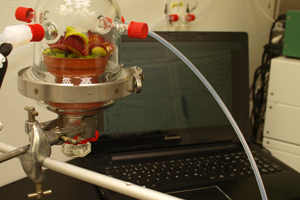Snap, Digest, Respire

Photo: Lukas Fasbender
The Venus flytrap captures insects for more than just nutritional purposes: A research team lead by Prof. Dr. Heinz Rennenberg and Lukas Fasbender from the Institute of Forest Sciences at the University of Freiburg has proven the carnivorous plant extracts also energy from its prey. The scientists recently presented their findings in the scientific journal „New Phytologist.“
The Venus flytrap can be found in the United States in areas with nutrient-depleted soil. The plant compensates for its environmental limitations by trapping insects in their outer green stomach: specialized leaf traps, which decompose the insects with the help of digestive juices.
By doing so, they are able to extract nutrients such as phosphorous and nitrogen lacking in the soil, but which are present in the insects themselves. Up until now, researchers assumed that energy production played no part in the process because they thought the oxidation from photosynthesis was sufficient for the plant’s energy needs. With the help of light energy during photosynthesis, oxygen and glucose are produced from carbon dioxide and water. The sugar can be transformed into energy through respiration, whereby carbon dioxide is emitted.
Through their experiment, researchers have discovered that the Venus flytrap indeed extracts energy from its prey. In order to prove their theory, the researchers placed artificial nutrients – a solution laced with the amino acid glutamine – into the leaf traps of the plant.
They used stable, non-radioactive 13C-isotopes, differing from other carbon atoms due to their higher mass, to label the glutamine carbon. With the help of an infrared laser they were able to prove that these 13C-isotopes from the prey occured in the carbon dioxide that the plant emitted, starting about one to two hours after feeding.
The scientists now assume that the process of ingestion and energy production in the Venus flytrap is more complex than thought: The carnivorous plant thus uses the energy it receives during photosynthesis to begin the digestive process and to access nutrients. In order to maintain this process, it produces additional energy by oxidizing amino acids that it extracts from its prey, thereby gaining access to yet another energy source.
Heinz Rennenberg is a Professor for Tree Physiology. Lukas Fasbender is a doctoral student for the Chair of Ecosystem Physiology in the Faculty for the Environment and Natural Resources at the University of Freiburg.
Originalveröffentlichung:
Lukas Fasbender, Daniel Maurer, Jürgen Kreuzwieser, Ines Kreuzer, Waltraud X. Schulze, Jörg Kruse, Dirk Becker, Saleh Alfarraj, Rainer Hedrich, Christiane Werner and Heinz Rennenberg (2017): The carnivorous Venus flytrap uses prey-derived amino acid carbon to fuel respiration. In: New Phytologist, doi: 10.1111/nph.14404
Contact:
Prof. Dr. Heinz Rennenberg
Institute of Forest Sciences
University of Freiburg
Tel.: 0761/203-8301
E-Mail: heinz.rennenberg@ctp.uni-freiburg.de
https://www.pr.uni-freiburg.de/pm/2017/pm.2017-01-20.8-en?set_language=en
Media Contact
All latest news from the category: Life Sciences and Chemistry
Articles and reports from the Life Sciences and chemistry area deal with applied and basic research into modern biology, chemistry and human medicine.
Valuable information can be found on a range of life sciences fields including bacteriology, biochemistry, bionics, bioinformatics, biophysics, biotechnology, genetics, geobotany, human biology, marine biology, microbiology, molecular biology, cellular biology, zoology, bioinorganic chemistry, microchemistry and environmental chemistry.
Newest articles

NASA: Mystery of life’s handedness deepens
The mystery of why life uses molecules with specific orientations has deepened with a NASA-funded discovery that RNA — a key molecule thought to have potentially held the instructions for…

What are the effects of historic lithium mining on water quality?
Study reveals low levels of common contaminants but high levels of other elements in waters associated with an abandoned lithium mine. Lithium ore and mining waste from a historic lithium…

Quantum-inspired design boosts efficiency of heat-to-electricity conversion
Rice engineers take unconventional route to improving thermophotovoltaic systems. Researchers at Rice University have found a new way to improve a key element of thermophotovoltaic (TPV) systems, which convert heat…



